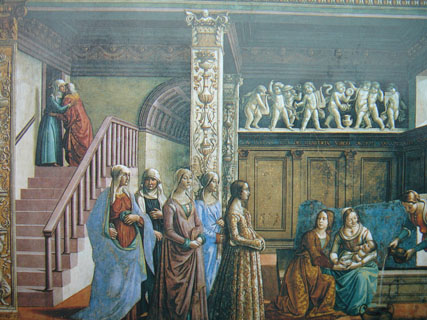Today is “International Midwives’ Day”, so in honour of that honourable profession I have chosen Domenico Ghirlandaio’s beautiful Renaissance fresco of The Nativity of the Virgin. The painter shows the Virgin Mary’s mother, St Anne, reclining in bed as a delegation of elegantly dressed ladies arrive to congratulate her on the successful delivery of her baby. The infant Madonna sucks her thumb and gurgles peacefully in the arms of one tenderly smiling midwife, while another kneels close by. As the visitors wait to greet the tired but happy mother, an attendant as graceful as an ancient Greek nymph wafts in and pours water into a finely worked bronze vessel. Mary, mother of God, is about to have her first bath.
The gospels make no reference to Mary before the Annunciation, and there is only a short and terse account of her birth in the apocrypha, so for the many rich details of the interior, and the sumptuous clothes worn by its inhabitants, Ghirlandaio drew on a mixture of his own imagination and the reality of upper-class life in Florence, circa 1490. St Anne’s bedchamber is done up in fashionable Florentine Renaissance style, with its classical frieze of playful putti (appropriate theme for a scene of birth), arranged over panels of intricately inlaid wood. These panels of intarsia, as they were known, are themselves decorated with curlicues of grotesque ornament based on antique wall-paintings that had only recently been excavated in Rome. Ghirlandaio seems to have been proud of these knowledgeably antiquarian touches, inscribing his own name as well as his family name into little rectangular boxes set within the intarsia. Just above, a Latin inscription in gold letters underlines the religious significance of the scene: “Your birth, O Virgin Mother, announced joy to the whole...


